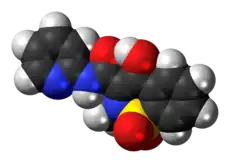Piroxicam
 | |
 | |
| Names | |
|---|---|
| Pronunciation | /paɪˈrɒksɪˌkæm/ |
| Trade names | Feldene, others[1] |
| Other names | Piroksikam, piroxikam |
IUPAC name
| |
| Clinical data | |
| Drug class | Nonsteroidal anti-inflammatory drug (NSAID) |
| Main uses | Pain, inflammation[2] |
| Side effects | Heartburn, nausea, diarrhea, rash, headache, swelling, ringing in the ears[2] |
| WHO AWaRe | UnlinkedWikibase error: ⧼unlinkedwikibase-error-statements-entity-not-set⧽ |
| Pregnancy category |
|
| Routes of use | By mouth |
| External links | |
| AHFS/Drugs.com | Monograph |
| MedlinePlus | a684045 |
| Legal | |
| Legal status | |
| Pharmacokinetics | |
| Protein binding | 99%[4] |
| Metabolism | Liver-mediated hydroxylation and glucuronidation[4] |
| Elimination half-life | 50 hours[4] |
| Excretion | Urine, faeces |
| Chemical and physical data | |
| Formula | C15H13N3O4S |
| Molar mass | 331.35 g·mol−1 |
| 3D model (JSmol) | |
SMILES
| |
InChI
| |
Piroxicam is a nonsteroidal anti-inflammatory drug (NSAID) used to treat pain and inflammation.[2] This includes in condition like arthritis and painful periods.[2] It is taken by mouth or applied to the skin.[2][5]
Common side effects include heartburn, nausea, diarrhea, rash, headache, swelling, and ringing in the ears.[2] Other side effects may include anaphylaxis, kidney problems, gastrointestinal bleeding, heart disease, heart failure, and high blood pressure.[2] Use in the later part of pregnancy may harm the baby.[2] It is in the oxicam family of medications and works by blocking COX-1 and COX-2.[2]
Piroxicam was patented in 1968 and approved for medical use in 1979.[6] It is available as a generic medication.[5] In the United Kingdom a month of medication costs the NHS about £5 as of 2021.[5] In the United States this amount costs about 30 USD.[7] It is marketed under many brand names.[1]
Medical uses
It is used in the treatment of rheumatoid and osteoarthritis, primary dysmenorrhoea, postoperative pain; and act as an analgesic, especially where there is an inflammatory component.[4] The European Medicines Agency issued a review of its use in 2007 and recommended that its use be limited to the treatment of chronic inflammatory conditions, as it is only in these circumstances that its risk-benefit ratio proves to be favourable.[8][9]
Dosage
It may be take at a dose of up to 20 mg per day.[5]
Side effects
As with other NSAIDs the principal side effects include: digestive complaints like nausea, discomfort, diarrhoea and bleeds or ulceration of the stomach, as well as headache, dizziness, nervousness, depression, drowsiness, insomnia, vertigo, hearing disturbances (such as tinnitus), high blood pressure, oedema, light sensitivity, skin reactions (including, albeit rarely, Stevens–Johnson syndrome and toxic epidermal necrolysis) and rarely, kidney failure, pancreatitis, liver damage, visual disturbances, pulmonary eosinophilia and alveolitis.[8] Compared to other NSAIDs it is more prone to causing gastrointestinal disturbances and serious skin reactions.[8]
In October 2020, the U.S. Food and Drug Administration (FDA) required the drug label to be updated for all nonsteroidal anti-inflammatory medications to describe the risk of kidney problems in unborn babies that result in low amniotic fluid.[10][11] They recommend avoiding NSAIDs in pregnant women at 20 weeks or later in pregnancy.[10][11]
Mechanism of action
Piroxicam is an NSAID and, as such, is a non-selective COX inhibitor possessing both analgesic and antipyretic properties.[8]
Chemical properties
Piroxicam exists as alkenol tautomer in organic solvents and as zwitterionic form in water.[12]
History
The project that produced piroxicam began in 1962 at Pfizer; the first clinical trial results were reported in 1977, and the product launched in 1980 under the brand name "Feldene".[13][14] Major patents expired in 1992[13] and the drug is marketed worldwide under many brandnames.[1]
Society and culture
Cost
In the U.S. the cost of this medication is $189 (USD) for 100 capsules (20 mg)[15]
.svg.png.webp) Piroxicam costs (US)
Piroxicam costs (US).svg.png.webp) Piroxicam prescriptions (US)
Piroxicam prescriptions (US)
See also
References
- 1 2 3 "Piroxicam Uses, Side Effects & Warnings". Drugs.com. Archived from the original on 28 August 2021. Retrieved 28 October 2021.
- 1 2 3 4 5 6 7 8 9 "Piroxicam Monograph for Professionals". Drugs.com. Archived from the original on 21 October 2021. Retrieved 28 October 2021.
- ↑ "Archive copy" (PDF). Archived (PDF) from the original on 2021-08-28. Retrieved 2021-01-28.
{{cite web}}: CS1 maint: archived copy as title (link) - 1 2 3 4 Brayfield, A, ed. (14 January 2014). "Piroxicam". Martindale: The Complete Drug Reference. London, UK: Pharmaceutical Press. Archived from the original on 28 August 2021. Retrieved 24 June 2014.
- 1 2 3 4 BNF 81: March-September 2021. BMJ Group and the Pharmaceutical Press. 2021. p. 1196. ISBN 978-0857114105.
- ↑ Fischer, Jnos; Ganellin, C. Robin (2006). Analogue-based Drug Discovery. John Wiley & Sons. p. 519. ISBN 9783527607495. Archived from the original on 2020-07-10. Retrieved 2020-09-06.
- ↑ "Piroxicam Prices, Coupons & Patient Assistance Programs". Drugs.com. Archived from the original on 24 January 2021. Retrieved 28 October 2021.
- 1 2 3 4 Joint Formulary Committee (2013). British National Formulary (BNF) (65 ed.). London, UK: Pharmaceutical Press. pp. 665, 673–674. ISBN 978-0-85711-084-8.
- ↑ "COMMITTEE FOR MEDICINAL PRODUCTS FOR HUMAN USE (CHMP) OPINION FOLLOWING AN ARTICLE 31(2) REFERRAL PIROXICAM CONTAINING MEDICINAL PRODUCTS" (PDF). European Medicines Agency. London, UK: European Medicines Agency. 20 September 2007. Archived (PDF) from the original on 23 July 2015. Retrieved 24 June 2014.
- 1 2 "FDA Warns that Using a Type of Pain and Fever Medication in Second Half of Pregnancy Could Lead to Complications". U.S. Food and Drug Administration (FDA) (Press release). 15 October 2020. Archived from the original on 16 October 2020. Retrieved 15 October 2020.
 This article incorporates text from this source, which is in the public domain.
This article incorporates text from this source, which is in the public domain. - 1 2 "NSAIDs may cause rare kidney problems in unborn babies". U.S. Food and Drug Administration. 21 July 2017. Archived from the original on 17 October 2020. Retrieved 15 October 2020.
 This article incorporates text from this source, which is in the public domain.
This article incorporates text from this source, which is in the public domain. - ↑ Ivanova D, Deneva V, Nedeltcheva D, Kamounah FS, Gergov G, Hansen PE, Kawauchi S, Antonov L (2015). "Tautomeric transformations of piroxicam in solution: a combined experimental and theoretical study". RSC Advances. 5 (40): 31852–31860. doi:10.1039/c5ra03653d.
- 1 2 Lombardino, JG; Lowe, JA 3rd (2004). "The role of the medicinal chemist in drug discovery--then and now". Nat Rev Drug Discov. 3 (10): 853–62. doi:10.1038/nrd1523. PMID 15459676. S2CID 11225541.. See: Archived 2015-07-09 at the Wayback Machine Box 1: Discovery of piroxicam (1962–1980)
- ↑ Weintraub M, Jacox RF, Angevine CD, Atwater EC (1977). "Piroxicam (CP 16171) in rheumatoid arthritis: a controlled clinical trial with novel assessment techniques". Journal of Rheumatology. 4 (4): 393–404. PMID 342691.
- ↑ "Piroxicam Prices, Coupons & Patient Assistance Programs". Drugs.com. Archived from the original on 24 January 2021. Retrieved 6 April 2021.
External links
| Identifiers: |
|---|
- Dean L (2019). "Piroxicam Therapy and CYP2C9 Genotype". In Pratt VM, McLeod HL, Rubinstein WS, et al. (eds.). Medical Genetics Summaries. National Center for Biotechnology Information (NCBI). PMID 30742401. Bookshelf ID: NBK537367. Archived from the original on 2020-10-26. Retrieved 2020-02-05.